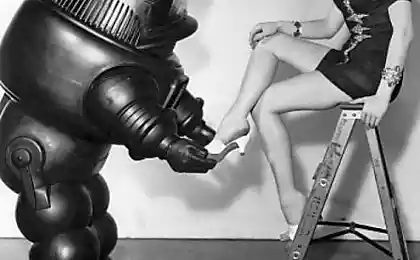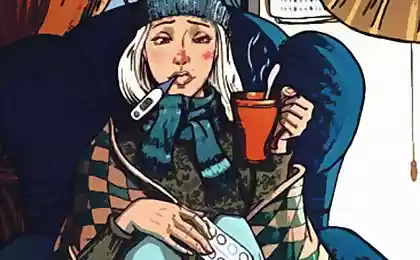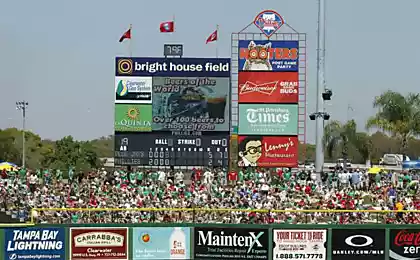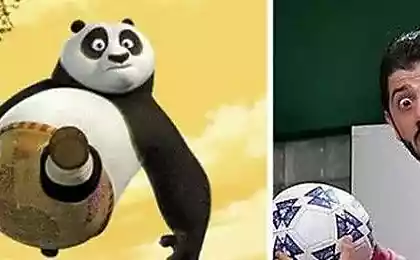1583
" First blood". History of creation
The sheriff of a small town to arrest a young drifter, when he refuses to leave the city. At the police station the police force trying to shave and wash guy, but he escapes and flees into the forest. Chase does not bring results - on the contrary, the cops themselves almost killed by Man. When this became known, in the old town of the military arrives and explains that "tramp" - from the elite commando unit, which led a guerrilla war in Vietnam. The police asked him to help with the arrest of a former slave, and it binds to the guy on the radio, to persuade him to give up and do not harm "friendly civilians." Commando, however, says that it does not hunt "civilian friendly" and cops gone too far. "They have shed the first blood, not me," - he said, insisting that only kicks back.
13 photo.
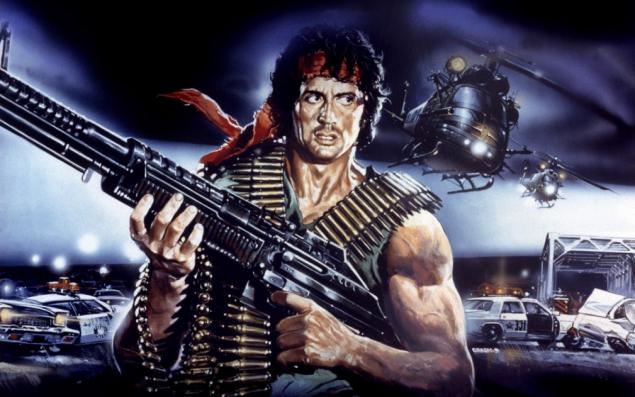
In the history of the XX century can be counted on the fingers of literary characters who have become international household name. Sherlock Holmes, Tarzan, James Bond ... and John Rambo - irresistible super-soldiers, who alone is worth an army. He was born in a novel by David Morrell and became world famous thanks to the film, in 1982 to conquer the cinemas of all capitalist countries. Like the novel, the painting - both tense thriller and a moving drama - called the "First Blood" (in Russian - "Rambo: First Blood»).
Like many Hollywood history, the history of "First Blood" started many years before the director Ted Kotcheff first shouted "Action!" To its founding novel was published in 1972, but it was not the beginning, but only a milestone in the Rambo fate. As acknowledged by David Morrell, he first thought of "First Blood" in 1968, in the midst of student unrest in Western countries.
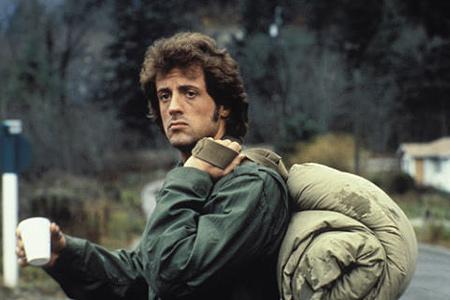
Canadian-born Morrell while at home just got a bachelor's degree in English Language Arts and moved to the US to continue her studies and become masters and doctors of sciences. As an outsider, a foreigner, he was not involved in the riots, but watched them close parallel watched on TV coverage of Vietnam and wanted to do something to support the anti-war rebels. So he decided to write a novel about a soldier who returns from war overseas and brings it with him, "fly off the rails" and arranging a massacre in a provincial town. Morrell conceived to show that the war - it's not a fun adventure and virtuous struggle against evil, and hell, soul destroying belligerent. It is also intended to show readers how terrible war, when it goes overseas and at home in the backyard. Morrell would like the Americans to at least briefly felt Vietnamese.
It was the first novel Morrell, and work on it proceeded with difficulty. While Morrell pored over the book, he became a teacher, and among its students there were many Vietnam veterans. By observing their behavior and listening to their stories about what they have experienced in Asia and in the United States, Morrell gradually "set up" the main character was originally based on Audie Murphy - known across America veteran of World War II. Murphy valiantly fought back with a pile of awards, became a star of westerns and until the end of his relatively short life (he died in a plane crash in 1971 at the age of 45 years) suffering from post-traumatic stress syndrome. Which is expressed in paranoia, attachment to the legal drugs, bouts of uncontrollable rage. And Murphy did not suffer in silence. He spoke candidly about what was happening to him, and fought for the improvement of the system of rehabilitation of veterans.
Once, while working on the novel Morrell reread the poems of Arthur Rimbaud and thinking about a short but colorful life of the poet of the XIX century, who participated in the uprising of the Paris Commune, and served as a mercenary in Indonesia (then the Dutch colony). The wife of the writer that day bought the popular apple varieties in the eastern US "Rambo" (the name of the class goes to the Swedish word Ramberget, which translates as "Crow Mountain"), and Morrell considers that this is a coincidence - a sign from above. So the main character of his book got a name Rambo and military callsign "The Raven." The name John, in turn, was not only the most popular in English-speaking countries, but also the natural name for a single soldier. After all, the US letter of girls, without waiting for the guys from the army, and announcing the break, called Dear John ... («Dear John ..."). However, it was only the name of the protagonist in the script - in the book he was simply Rambo.
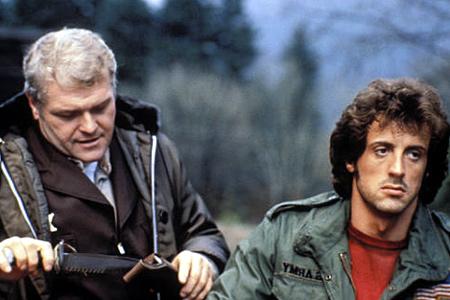
When the "First Blood" was completed and given to the press, it was hard and brutal work. Exploded like a bomb on the abuse of police tramp Rambo and kill the guilty, and innocent. He literally filled up the corpses of the town and died in the final clash with the sheriff Tizlom (continued plant theme, Morrell named in honor of the hero of the prickly plants, which in Russia is known as teasel). Veteran Tizl Korea, too, is in the final went to the morgue. Of the three main characters survived only Captain Sam Trautmen - head of the school of special forces, which were prepared Rambo (unlike the movie, the book, these characters were barely familiar). A hint of the writer was clear: the veterans come and go, and the "Uncle Sam", that is, the American military establishment survives and continues to send young men to the front. Whether Korea, Vietnam or some other "hot spots».
Why Morrell was important to make Tizla veteran? Firstly, he did not want to cast a shadow on all veterans and argued that each of them - a grenade without checks. Therefore, it was important to show the different veterans, with different histories and different behavior. Second, the book Morrell noted that Tizl partly understands and sympathizes with Rambo - it would be impossible, if the sheriff did not visited the front. Third, even envied Tizl generation of Rambo, which attracted worldwide attention, while veterans of the Korean War were in 1970 almost forgotten. That's why he did not give the guy favors when they learned that he served.
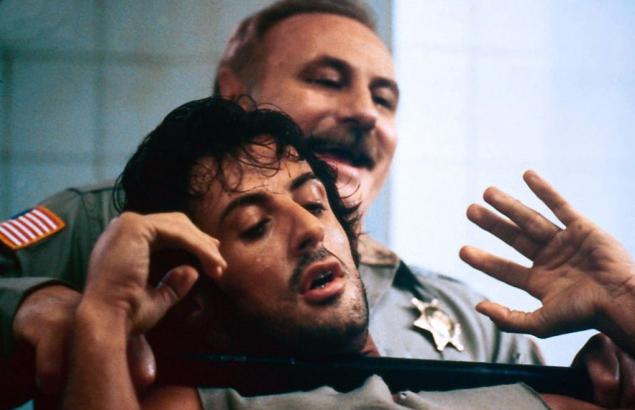
Gripping story, aggressive action and anti-war enthusiasm - a combination of Hollywood attracted more than tax breaks, and the "First Blood" was quickly purchased for the film adaptation. However, it turned out to be a hard nut to crack. Who has not tried his hand at writing the script who just did not apply for the director's chair, who was not invited to a major role! The project succeeded five studios, passed through the hands of two dozen writers on the performance of the role of Rambo thought all the stars of the 1970s, from Robert De Niro to John Travolta. But whenever there were an insurmountable obstacle.
As a general rule, potential ekranizatory "First Blood" stumbled on the excessive brutality of the book. When you transfer the action of the novel in the film Rambo appeared as a terrorist, deserve neither sympathy nor empathy. Those who are not confused, ran into that after the Vietnam War, anti-war propaganda has been irrelevant, and the audience did not want to reopen the Hollywood-start was to heal the wound.
Finally, in the early 1980's "First Blood" has passed into the hands of Lebanese Mario Kassar and Andrew Vajna Hungarian owners established a few years earlier independent studio Carolco. They bought the project on the advice of the Canadian director Ted Kotcheffa, who worked on the "blood" when she was engaged in studio Warner. By the time mentioned the Vietnam War had not met with hostility, and the ratio of the veterans was better than in the late 1960s, when protesters against the war called them "murderers" and greeted them as criminals. Since the partners decided that the "first blood" has finally come - not as an anti-war film, but as a movie about a forgotten veteran.
Previous paint Mario and Vine was the military-sports drama "Victory" (Scene analogue of our "Match", only the western prisoners, playing football with the German jailers), and they immediately thought about the invitation to the "First Blood" Sylvester Stallone, who "Victory" portrayed the American goalkeeper (by the way, one of the members of his "team" was even the great Pele).

Stallone at the time was in a difficult position. He remained a world-renowned, but none of his paintings, with the exception of "Rocky" and "Rocky 2" has not achieved substantial commercial success. He did not want to appear as one actor, and he longed to pay tribute to those who fought for America, but it was not accepted by the country as a hero. So he quickly agreed to play Rambo - on the condition that he would be allowed to rewrite the script and create a hero, what he will be comfortable to play. The producers and who undertook to put a picture Kotcheff not mind. They remembered that the scenario of "Rocky" Stallone brought a nomination for "Oscar" and they wanted to Rambo was more like a Rocky than ruthless maniac.
Taking the scenario Kozolla Michael and William Sakhayma (the most successful of the set written at that time), Stallone took up softening the image of Rambo. He insisted on the fact that the hero actually did not kill anyone (throwing a stone into a helicopter and skidyvanie cars off the road is difficult to call the murder) and that Rambo seemed kind of naive big kid, growing up only when he has to survive and fight. In turn, the producers demanded that the picture was more action and less talk. Experts of international sales, they would facilitate the work of future translators and directors of dubbing.

Changed in the new scenarios and Trautmen with Tizlom. The first of the detached chief became a "father of the soldiers" who not only finished Rambo, and fought with him. Second, in contrast, almost lost his veterancy which is never mentioned in the film. Attentive viewers, however, may notice military medals in his office, and noted that the final Tizl does not behave as a police officer and as a sniper. These changes were necessary to strengthen the "side Rambo" and weaken "the sheriff's side" to ensure that the audience will not hurt for those who shed the first blood, but for someone whose blood has been spilled. Even if it will behave like a criminal.
Selecting the actors for these roles, the sheriff gave Kotcheff actor Brian Dennehy, former Marine (he managed to serve in the short period when America was not at war, but it is often said that he was in Vietnam). Dennehy and Stallone has starred together in the historical social drama "Fist", but there have Dennehy was far less significant role. American Irishman impressed the director of its imposing appearance and the ability to find the role of shades that were not in the script.
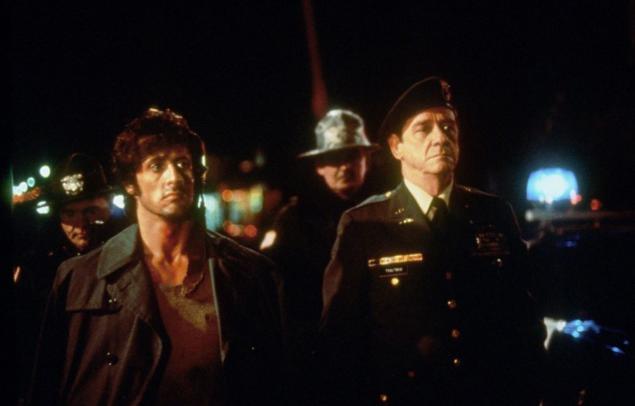
The role was originally charged Trautmena celebrated Kirk Douglas, the hero of "Spartacus" and many other legendary bands. Douglas was ready to act, but he found the claim to the script, and when the filmmakers have refused to rewrite the text dictation stars, he fled from the shooting. I had to quickly find a replacement, and the new Trautmenom became a television actor Richard Crenna, who entered the image literally from the wheels started filming immediately after reading the script.
The film also starred David Caruso, while an aspiring singer and future star of the TV series "NYPD Blue" and «CSI: Crime Scene Investigation - Miami." The role he was not too important (he played one of the police), but bright red actor immediately attracted attention, and his colleagues talked to each other, that guy will go far if the right plays his cards.
As Stallone, as already mentioned, was considered profitable star, only when playing Rocky, find the money for the "First Blood" was not easy. In the end, Mario Kassar simply took advantage of the fact that his godfather (the most common, not criminal) was a "bump" in a major European bank, and he took a loan of $ 18 million and promised godfather, it is easy to "Provisional Government" film to foreign distributors, as soon as they can show the cutting of the scenes filmed. It was quite presumptuous, but the producer is rather advantage than a disadvantage.
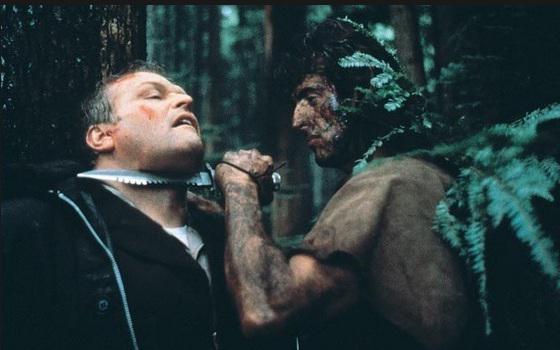
In the book, the action develops in Kentucky, but the filmmakers felt that shooting in Canada, less expensive, and because the scene was moved to northwestern Washington (hello, "Twilight"!). Filming also took place a little to the north, bordering with Washington in the Canadian province of British Columbia, near Vancouver (incidentally, the same parts, where decades later filmed "Twilight"). American town called Hope ("Hope") depicts a Canadian town called Hope, but hopefully it was bad. Local mills were closed one after the other, and the townspeople were out of work. For Hollywood-true, it was a very convenient, because the depressive town, the cheaper it is easier to remove and to negotiate with the residents and authorities. In turn, forest scenes were created in the provincial forest park British Columbia "Golden Ears", which got its name in honor of the two mountain ridges.
While British Columbia and is located in the north of North America, it is famous for its mild and warm climate. Its densely populated areas average annual temperature is 12 degrees Celsius, making it the warmest area of Canada. Therefore, the producers of "First Blood" had hoped that with the planned for the winter shooting will not be big problems. However, the weather, unlike the Canadians refused to cooperate with the southerners. Almost every day it was a rain or snow, chilly wind blowing and the temperature sometimes dropped to minus significantly, especially during the production of the foothills. And if crew members could dress for the weather, that Stallone had to run in the frame in jeans and a T-shirt. We can only guess how he has not earned pneumonia.
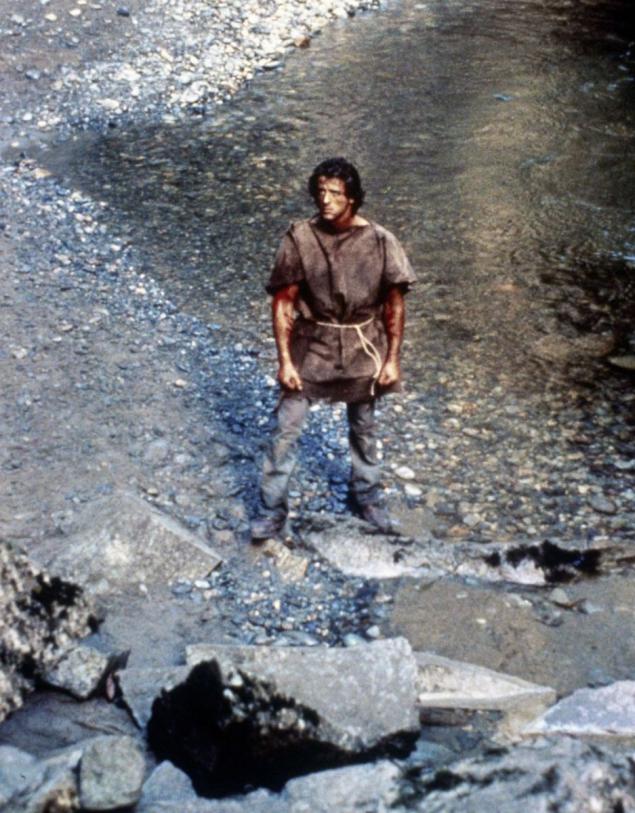
In general, the actor 200% fulfilled his fee. He was suffering from a cold, he wore makeshift robe of rotten matting (costume picked up the cloth at an abandoned sawmill and then took care of her as the apple of the eye, because the other is the same they did not have), climbing on slippery rocks, way along this underground caves and fought on most of these rats. True, not the forest, and laboratory - dressers painted white rats gray.
Stallone also performed three-quarters of the tricks of his character. The actor at the time was not so valuable to be kept as far away from risky shots. Of course, not without injury. For example, when shooting Rambo fall on branches of trees Stallone broke several ribs, because not landed belly and breasts. Well, at least he did not have to portray the pain and harsh despair, and the audience saw the star in the picture, and not a stunt.
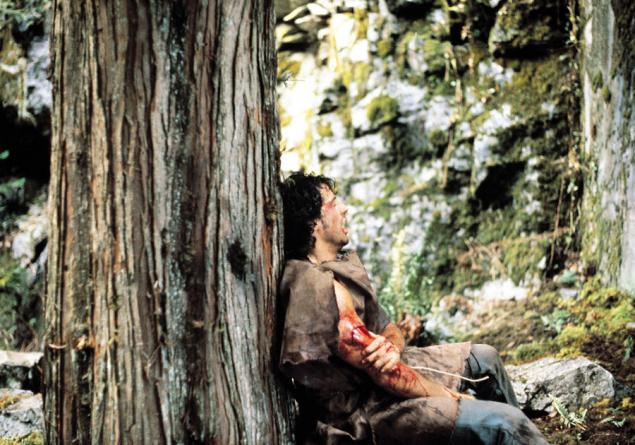
Other creators of the picture, too, sometimes had difficulty. The weather and the mountains were equally unmerciful to all, and in Canadian forests were so easy to get lost, that the members of the banned group far away from one another. In this forest was misty, wet and rocky - a great place for those who want to break a leg or split head, but not for those who want to return to Hollywood safe and sound.
The picturesque region, where was filmed "First Blood," will allow many in the film to improvise on the spot. For example, the same hoodie Rambo or scene in the cave. However, were in Hollywood-and home-made. First of all, the famous knife of the protagonist, developed a master from Arkansas Jimmy Lyle. The film was shown only a few of its functions, but the knife was all that could be useful for survival - from matches to a screwdriver. Stallone liked this knife so that he wanted to kill them in a frame any large wild animal, but Canadian huntsman advised him not to mess with rabbits even that painful bite. But nothing of the wild boars and pumas or speech could not be. As a result, the film was included wild boar hunting scene, but actually killing has not been demonstrated. To avoid problems, like an animal, and with the audience.
From the very beginning of the film the main dramaturgical stumbling block was the final scene. In the book, Rambo died, and many believed that he should die in the film (Hollywood prefers to villains, even tragic and nice, get what they deserve). Stallone, however, insisted that Rambo must survive. Because otherwise it would turn out that disrupt the veteran is no turning back, and it was not the best "promise" for people who are already depressed. In addition, the actor felt that the audience would be pleased if the hero whom they empathize, to go to jail rather than in a cemetery.
And not being able to find a solution during the filming, Kotcheff made two final options - one in which Rambo surrendered, and one in which he commits suicide. Both versions were tested on audiences during the preview, and the response has demonstrated the truth of Stallone. Option suicide was hissed, and the version with rescue greeted with applause.
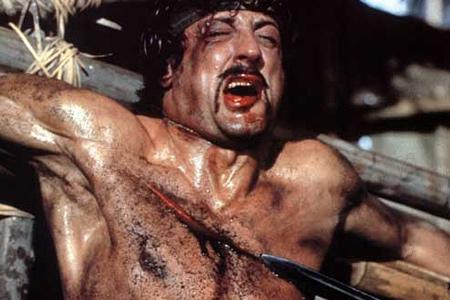
13 photo.

In the history of the XX century can be counted on the fingers of literary characters who have become international household name. Sherlock Holmes, Tarzan, James Bond ... and John Rambo - irresistible super-soldiers, who alone is worth an army. He was born in a novel by David Morrell and became world famous thanks to the film, in 1982 to conquer the cinemas of all capitalist countries. Like the novel, the painting - both tense thriller and a moving drama - called the "First Blood" (in Russian - "Rambo: First Blood»).
Like many Hollywood history, the history of "First Blood" started many years before the director Ted Kotcheff first shouted "Action!" To its founding novel was published in 1972, but it was not the beginning, but only a milestone in the Rambo fate. As acknowledged by David Morrell, he first thought of "First Blood" in 1968, in the midst of student unrest in Western countries.

Canadian-born Morrell while at home just got a bachelor's degree in English Language Arts and moved to the US to continue her studies and become masters and doctors of sciences. As an outsider, a foreigner, he was not involved in the riots, but watched them close parallel watched on TV coverage of Vietnam and wanted to do something to support the anti-war rebels. So he decided to write a novel about a soldier who returns from war overseas and brings it with him, "fly off the rails" and arranging a massacre in a provincial town. Morrell conceived to show that the war - it's not a fun adventure and virtuous struggle against evil, and hell, soul destroying belligerent. It is also intended to show readers how terrible war, when it goes overseas and at home in the backyard. Morrell would like the Americans to at least briefly felt Vietnamese.
It was the first novel Morrell, and work on it proceeded with difficulty. While Morrell pored over the book, he became a teacher, and among its students there were many Vietnam veterans. By observing their behavior and listening to their stories about what they have experienced in Asia and in the United States, Morrell gradually "set up" the main character was originally based on Audie Murphy - known across America veteran of World War II. Murphy valiantly fought back with a pile of awards, became a star of westerns and until the end of his relatively short life (he died in a plane crash in 1971 at the age of 45 years) suffering from post-traumatic stress syndrome. Which is expressed in paranoia, attachment to the legal drugs, bouts of uncontrollable rage. And Murphy did not suffer in silence. He spoke candidly about what was happening to him, and fought for the improvement of the system of rehabilitation of veterans.
Once, while working on the novel Morrell reread the poems of Arthur Rimbaud and thinking about a short but colorful life of the poet of the XIX century, who participated in the uprising of the Paris Commune, and served as a mercenary in Indonesia (then the Dutch colony). The wife of the writer that day bought the popular apple varieties in the eastern US "Rambo" (the name of the class goes to the Swedish word Ramberget, which translates as "Crow Mountain"), and Morrell considers that this is a coincidence - a sign from above. So the main character of his book got a name Rambo and military callsign "The Raven." The name John, in turn, was not only the most popular in English-speaking countries, but also the natural name for a single soldier. After all, the US letter of girls, without waiting for the guys from the army, and announcing the break, called Dear John ... («Dear John ..."). However, it was only the name of the protagonist in the script - in the book he was simply Rambo.

When the "First Blood" was completed and given to the press, it was hard and brutal work. Exploded like a bomb on the abuse of police tramp Rambo and kill the guilty, and innocent. He literally filled up the corpses of the town and died in the final clash with the sheriff Tizlom (continued plant theme, Morrell named in honor of the hero of the prickly plants, which in Russia is known as teasel). Veteran Tizl Korea, too, is in the final went to the morgue. Of the three main characters survived only Captain Sam Trautmen - head of the school of special forces, which were prepared Rambo (unlike the movie, the book, these characters were barely familiar). A hint of the writer was clear: the veterans come and go, and the "Uncle Sam", that is, the American military establishment survives and continues to send young men to the front. Whether Korea, Vietnam or some other "hot spots».
Why Morrell was important to make Tizla veteran? Firstly, he did not want to cast a shadow on all veterans and argued that each of them - a grenade without checks. Therefore, it was important to show the different veterans, with different histories and different behavior. Second, the book Morrell noted that Tizl partly understands and sympathizes with Rambo - it would be impossible, if the sheriff did not visited the front. Third, even envied Tizl generation of Rambo, which attracted worldwide attention, while veterans of the Korean War were in 1970 almost forgotten. That's why he did not give the guy favors when they learned that he served.

Gripping story, aggressive action and anti-war enthusiasm - a combination of Hollywood attracted more than tax breaks, and the "First Blood" was quickly purchased for the film adaptation. However, it turned out to be a hard nut to crack. Who has not tried his hand at writing the script who just did not apply for the director's chair, who was not invited to a major role! The project succeeded five studios, passed through the hands of two dozen writers on the performance of the role of Rambo thought all the stars of the 1970s, from Robert De Niro to John Travolta. But whenever there were an insurmountable obstacle.
As a general rule, potential ekranizatory "First Blood" stumbled on the excessive brutality of the book. When you transfer the action of the novel in the film Rambo appeared as a terrorist, deserve neither sympathy nor empathy. Those who are not confused, ran into that after the Vietnam War, anti-war propaganda has been irrelevant, and the audience did not want to reopen the Hollywood-start was to heal the wound.
Finally, in the early 1980's "First Blood" has passed into the hands of Lebanese Mario Kassar and Andrew Vajna Hungarian owners established a few years earlier independent studio Carolco. They bought the project on the advice of the Canadian director Ted Kotcheffa, who worked on the "blood" when she was engaged in studio Warner. By the time mentioned the Vietnam War had not met with hostility, and the ratio of the veterans was better than in the late 1960s, when protesters against the war called them "murderers" and greeted them as criminals. Since the partners decided that the "first blood" has finally come - not as an anti-war film, but as a movie about a forgotten veteran.
Previous paint Mario and Vine was the military-sports drama "Victory" (Scene analogue of our "Match", only the western prisoners, playing football with the German jailers), and they immediately thought about the invitation to the "First Blood" Sylvester Stallone, who "Victory" portrayed the American goalkeeper (by the way, one of the members of his "team" was even the great Pele).

Stallone at the time was in a difficult position. He remained a world-renowned, but none of his paintings, with the exception of "Rocky" and "Rocky 2" has not achieved substantial commercial success. He did not want to appear as one actor, and he longed to pay tribute to those who fought for America, but it was not accepted by the country as a hero. So he quickly agreed to play Rambo - on the condition that he would be allowed to rewrite the script and create a hero, what he will be comfortable to play. The producers and who undertook to put a picture Kotcheff not mind. They remembered that the scenario of "Rocky" Stallone brought a nomination for "Oscar" and they wanted to Rambo was more like a Rocky than ruthless maniac.
Taking the scenario Kozolla Michael and William Sakhayma (the most successful of the set written at that time), Stallone took up softening the image of Rambo. He insisted on the fact that the hero actually did not kill anyone (throwing a stone into a helicopter and skidyvanie cars off the road is difficult to call the murder) and that Rambo seemed kind of naive big kid, growing up only when he has to survive and fight. In turn, the producers demanded that the picture was more action and less talk. Experts of international sales, they would facilitate the work of future translators and directors of dubbing.

Changed in the new scenarios and Trautmen with Tizlom. The first of the detached chief became a "father of the soldiers" who not only finished Rambo, and fought with him. Second, in contrast, almost lost his veterancy which is never mentioned in the film. Attentive viewers, however, may notice military medals in his office, and noted that the final Tizl does not behave as a police officer and as a sniper. These changes were necessary to strengthen the "side Rambo" and weaken "the sheriff's side" to ensure that the audience will not hurt for those who shed the first blood, but for someone whose blood has been spilled. Even if it will behave like a criminal.
Selecting the actors for these roles, the sheriff gave Kotcheff actor Brian Dennehy, former Marine (he managed to serve in the short period when America was not at war, but it is often said that he was in Vietnam). Dennehy and Stallone has starred together in the historical social drama "Fist", but there have Dennehy was far less significant role. American Irishman impressed the director of its imposing appearance and the ability to find the role of shades that were not in the script.

The role was originally charged Trautmena celebrated Kirk Douglas, the hero of "Spartacus" and many other legendary bands. Douglas was ready to act, but he found the claim to the script, and when the filmmakers have refused to rewrite the text dictation stars, he fled from the shooting. I had to quickly find a replacement, and the new Trautmenom became a television actor Richard Crenna, who entered the image literally from the wheels started filming immediately after reading the script.
The film also starred David Caruso, while an aspiring singer and future star of the TV series "NYPD Blue" and «CSI: Crime Scene Investigation - Miami." The role he was not too important (he played one of the police), but bright red actor immediately attracted attention, and his colleagues talked to each other, that guy will go far if the right plays his cards.
As Stallone, as already mentioned, was considered profitable star, only when playing Rocky, find the money for the "First Blood" was not easy. In the end, Mario Kassar simply took advantage of the fact that his godfather (the most common, not criminal) was a "bump" in a major European bank, and he took a loan of $ 18 million and promised godfather, it is easy to "Provisional Government" film to foreign distributors, as soon as they can show the cutting of the scenes filmed. It was quite presumptuous, but the producer is rather advantage than a disadvantage.

In the book, the action develops in Kentucky, but the filmmakers felt that shooting in Canada, less expensive, and because the scene was moved to northwestern Washington (hello, "Twilight"!). Filming also took place a little to the north, bordering with Washington in the Canadian province of British Columbia, near Vancouver (incidentally, the same parts, where decades later filmed "Twilight"). American town called Hope ("Hope") depicts a Canadian town called Hope, but hopefully it was bad. Local mills were closed one after the other, and the townspeople were out of work. For Hollywood-true, it was a very convenient, because the depressive town, the cheaper it is easier to remove and to negotiate with the residents and authorities. In turn, forest scenes were created in the provincial forest park British Columbia "Golden Ears", which got its name in honor of the two mountain ridges.
While British Columbia and is located in the north of North America, it is famous for its mild and warm climate. Its densely populated areas average annual temperature is 12 degrees Celsius, making it the warmest area of Canada. Therefore, the producers of "First Blood" had hoped that with the planned for the winter shooting will not be big problems. However, the weather, unlike the Canadians refused to cooperate with the southerners. Almost every day it was a rain or snow, chilly wind blowing and the temperature sometimes dropped to minus significantly, especially during the production of the foothills. And if crew members could dress for the weather, that Stallone had to run in the frame in jeans and a T-shirt. We can only guess how he has not earned pneumonia.

In general, the actor 200% fulfilled his fee. He was suffering from a cold, he wore makeshift robe of rotten matting (costume picked up the cloth at an abandoned sawmill and then took care of her as the apple of the eye, because the other is the same they did not have), climbing on slippery rocks, way along this underground caves and fought on most of these rats. True, not the forest, and laboratory - dressers painted white rats gray.
Stallone also performed three-quarters of the tricks of his character. The actor at the time was not so valuable to be kept as far away from risky shots. Of course, not without injury. For example, when shooting Rambo fall on branches of trees Stallone broke several ribs, because not landed belly and breasts. Well, at least he did not have to portray the pain and harsh despair, and the audience saw the star in the picture, and not a stunt.

Other creators of the picture, too, sometimes had difficulty. The weather and the mountains were equally unmerciful to all, and in Canadian forests were so easy to get lost, that the members of the banned group far away from one another. In this forest was misty, wet and rocky - a great place for those who want to break a leg or split head, but not for those who want to return to Hollywood safe and sound.
The picturesque region, where was filmed "First Blood," will allow many in the film to improvise on the spot. For example, the same hoodie Rambo or scene in the cave. However, were in Hollywood-and home-made. First of all, the famous knife of the protagonist, developed a master from Arkansas Jimmy Lyle. The film was shown only a few of its functions, but the knife was all that could be useful for survival - from matches to a screwdriver. Stallone liked this knife so that he wanted to kill them in a frame any large wild animal, but Canadian huntsman advised him not to mess with rabbits even that painful bite. But nothing of the wild boars and pumas or speech could not be. As a result, the film was included wild boar hunting scene, but actually killing has not been demonstrated. To avoid problems, like an animal, and with the audience.
From the very beginning of the film the main dramaturgical stumbling block was the final scene. In the book, Rambo died, and many believed that he should die in the film (Hollywood prefers to villains, even tragic and nice, get what they deserve). Stallone, however, insisted that Rambo must survive. Because otherwise it would turn out that disrupt the veteran is no turning back, and it was not the best "promise" for people who are already depressed. In addition, the actor felt that the audience would be pleased if the hero whom they empathize, to go to jail rather than in a cemetery.
And not being able to find a solution during the filming, Kotcheff made two final options - one in which Rambo surrendered, and one in which he commits suicide. Both versions were tested on audiences during the preview, and the response has demonstrated the truth of Stallone. Option suicide was hissed, and the version with rescue greeted with applause.











